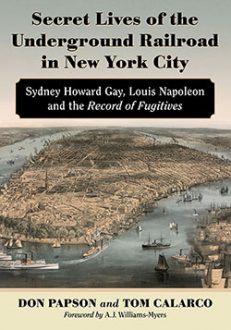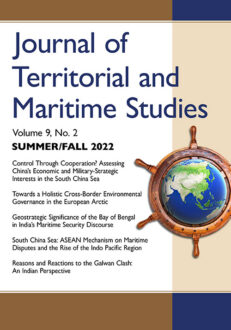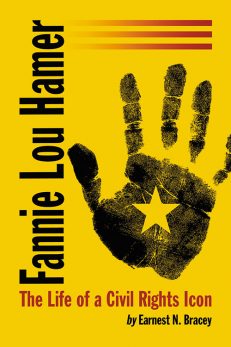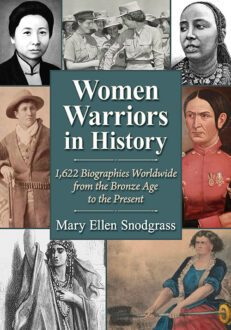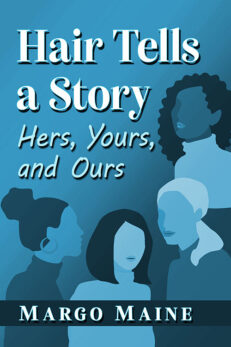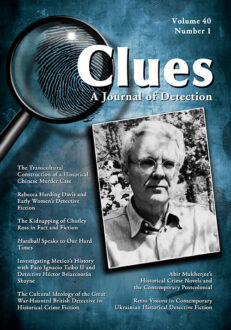Clues: A Journal of Detection, Vol. 40, No. 1 (Spring 2022)
Print Back Issue$30.00
In stock
About the Book
BACK ISSUE
This is a single back issue only. To order a current subscription, or for more information, please visit the journal’s web page at CluesJournal.com. Back issues from earlier volumes of Clues are available for order subject to availability. Also, single issues of the current volume may be ordered one at a time. Individuals may order back issues directly from our online catalog, and the charge for individuals is $30 (excluding postage). Issues from Volume 33 to the present are also available in ebook format on Kindle, Nook and Google Play.
The charge for single issues for institutions is $75 per issue (excluding postage). If your institution requires a back issue, please contact us to order at the appropriate rate.
About the Author(s)
Bibliographic Details
Executive Editor Caroline Reitz
Managing Editor Elizabeth Foxwell
Consulting Editor Margaret Kinsman
Format: softcover (7 x 10)
Pages: 131
Bibliographic Info:
Copyright Date: 2022
ISSN 0742-4248
Imprint: McFarland
Table of Contents
CLUES
A Journal of Detection
Theme Issue:
Guest Editor:
Historical Crime Fiction: A Cushion on the Seat
rosemary erickson johnsen 5
The guest editor of Clues 40.1 on historical crime fiction provides a brief history of related scholarship and discusses post–WWI India-set series by Massey and Mukherjee as representative of emerging trends. She previews the issue’s articles on mysteries set in China, India, Latin America, Ukraine, and the United States.
Editor’s Note
caroline reitz 12
Caroline Reitz, the executive editor of Clues, discusses two essays that appear in Clues 40.1 and a new call for submissions on pedagogy.
Rebecca Harding Davis and Early Women’s Detective Fiction
alicia mischa renfroe 14
In Peterson’s Magazine, Rebecca Harding Davis developed one of American fiction’s earliest recurring detective figures in several mysteries that foreground the antebellum South as a historical setting. These stories illustrate the genre’s productive intersection with the gothic, destabilize narratives of the past, and complicate the detective’s traditional role in restoring social order.
Hardball Speaks to Our Hard Times
margaret j. oakes 26
The settings of Sara Paretsky’s Hardball are Chicago’s glittering but decrepit political scene in the late 2000s and an open housing march led by Dr. Martin Luther King Jr. in 1966 that became volatile and violent. Hardball’s instructional text shows the contemporary consequences of systemic racism stemming from Jim Crow laws, the development of police power, and waves of immigration.
Investigating Mexico’s History with Paco Ignacio Taibo II and Detective Héctor Belascoarán Shayne: On Which Side Are You?
patricia varas 37
This essay examines Paco Ignacio Taibo II’s approach to history as an effort to capture or rewrite well-known yet forgotten episodes in Mexican history. By retelling the 1971 Corpus Christi student massacre, channeling Pancho Villa’s ghost, and recovering Aztec artifacts in his novels, he ensures that his readers will not forget this history, providing a controversial insight into today’s Mexico.
Ukrainian Hero and the Habsburg Monarchy: Retro Visions in Contemporary Ukrainian Historical Detective Fiction
sofiya filonenko 48
The series by contemporary Ukrainian writer Bogdan Kolomiychuk presents the adventures of police officer Adam Vistovych in Lviv (aka Lemberg). The author’s depiction of the Austro-Hungarian Empire in the early-twentieth century and its colony—Ukraine—highlights the social, political, national, and historical aspects of the mystery genre.
“The Truth Is Rarely Pure and Never Simple”: The Kidnapping of Charley Ross in Fact and Fiction
phyllis m. betz 59
This article compares the differences between Carrie Hagen’s nonfiction reconstruction of the 1874 kidnapping of Charley Ross and Mark Graham’s use of this event in his historical mystery. The main emphasis is how details of the actual event are altered to fit the requirements of each narrative form.
The Transcultural Construction of a Historical Chinese Murder Case:
The Ninefold Murder
sabrina yuan hao 68
This article explores the cross-cultural adaptations of a historical Chinese murder case. Focusing on three key texts published by An He in 1809, Wu Jianren in 1904, and Robert van Gulik in 1958, it investigates the potential of historicity to be used by authors of crime fiction to address concerns of their own times.
Abir Mukherjee’s Historical Crime Novels and the Contemporary Postcolonial
molly slavin 80
Abir Mukherjee’s historical crime novels set in the British Raj interrogate colonial structures of violence. The author argues that Mukherjee uses these novels to riff on Golden Age detective novel tropes and communicate knowledge about imperialism, history, and postcolonialism to mass market detective novel readers in the twenty-first century.
The Cultural Ideology of the Great War–Haunted British Detective in Historical Crime Fiction
marzena sokołowska-paryż 90
This article examines the cultural ideology underlying the constructions of the war-haunted detective in the historical crime fiction series by Rennie Airth, Jonathan Hicks, Charles Todd, and Jacqueline Winspear. These (re)imaginings of the Great War demonstrate the capacity of this literary genre to perpetuate the futility myth in the contemporary cultural memory of the 1914–18 British experience.
ESSAYS
Time and Detective Novels: Exploring the Past and the Night in Ian Rankin’s John Rebus Series
ian r. cook 102
Given that time is an important theme within detective novels, this article explores the portrayal of time in Ian Rankin’s John Rebus series. More precisely, it draws on the concepts of temporality and relationality to critically examine two important temporal dimensions in the series: the past and the night.
Dick Francis and the Fine Arts
fred erisman 114
Apart from P. D. James with Adam Dalgleish, mystery authors have rarely used an artist as their protagonist. Between 1972 and 2000, Dick Francis wrote seven such books, contrasting the artist’s world with the professional detective’s and exploring ways in which art equips the amateur to be as effective a crime-solving entity as the professional.
REVIEWS
Donald K. Hartman, Ed. The Hypno-Ripper
elyssa warkentin 125
Steven Powell, Ed. The Big Somewhere: Essays on James Ellroy’s Noir World
deirdre condit 126
Janice Allan, Jesper Gulddal, Stewart King, and Andrew Pepper, Eds.
The Routledge Companion to Crime Fiction
rosa haro fernández 128
Phyllis M. Betz, Ed. Reading the Cozy Mystery: Critical Essays on an
Underappreciated Subgenre
pamela bedore 129
Author Guidelines are on page 131.


